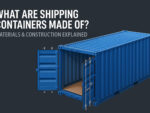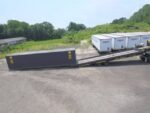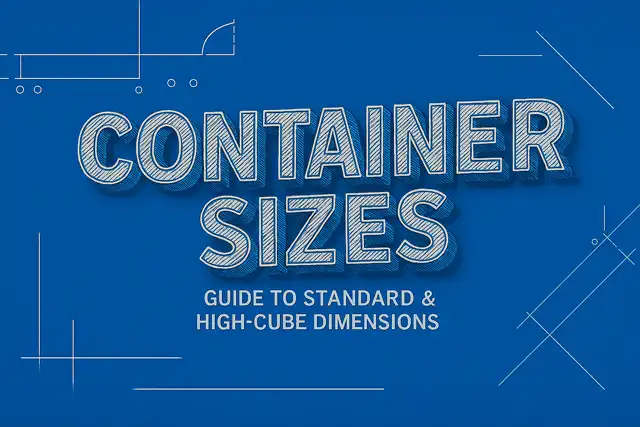
Quick Guide to Common Shipping Container Sizes
Understanding shipping container sizes is crucial whether you’re planning a commercial shipment, setting up a mobile office, or seeking extra on-site storage. From standard 20-foot containers to larger 40-foot and high-cube options, this guide offers a detailed breakdown of dimensions and use cases to help you choose the right fit.
Why Understanding Container Dimensions Matters
When it comes to logistics and portable storage, choosing the right container size can save time, money, and hassle. Depending on your needs—whether you’re storing construction equipment or moving merchandise—different sizes offer specific benefits:
- Optimize storage space without overpaying for unused volume
- Ensure compatibility with transportation regulations
- Streamline loading and unloading operations
Standard Container Sizes and Dimensions
The two most common shipping container sizes are 20-foot and 40-foot. Both come in standard height (8’6″) and high-cube (9’6″) variations.
20-Foot Container Dimensions
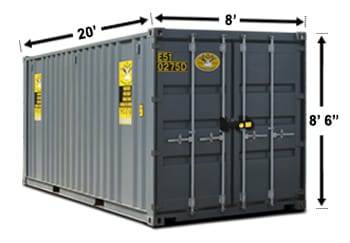
- Exterior Dimensions: 20′ L x 8′ W x 8’6″ H
- Interior Dimensions: Approximately 19’4″ L x 7’8″ W x 7’10” H
- Max Payload: About 55,126 lbs
- Use Case: Ideal for small equipment, local moves, or limited site space
40-Foot Container Dimensions
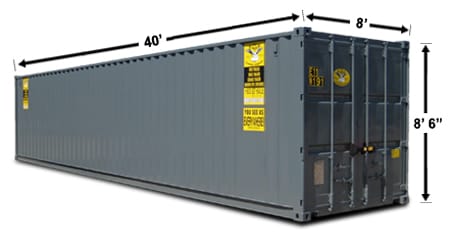
- Exterior Dimensions: 40′ L x 8′ W x 8’6″ H
- Interior Dimensions: Approximately 39’5″ L x 7’8″ W x 7’10” H
- Max Payload: About 59,039 lbs
- Use Case: Best for bulk freight, long-distance transport, or commercial storage
High-Cube Container Dimensions: Extra Height and Storage Space
High-cube containers are a taller alternative to standard containers, offering one extra foot of vertical space (9’6″ total height). That translates into more cubic capacity, which can be a game-changer for certain applications.
20-Foot High-Cube Container Dimensions
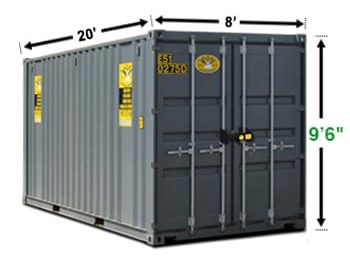
- Exterior Dimensions: 20′ L x 8′ W x 9’6″ H
- Interior Dimensions: Approximately 19’4″ L x 7’8″ W x 8’10” H
- Max Payload: About 54,000 lbs
- Use Case: Ideal when vertical space is crucial but the site can’t accommodate a 40-foot container
40-Foot High-Cube Container Dimensions
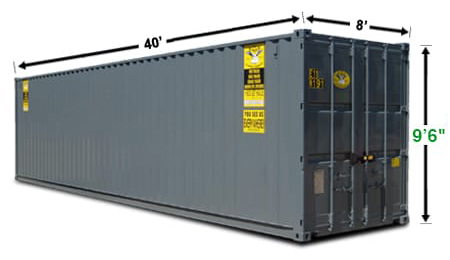
- Exterior Dimensions: 40′ L x 8′ W x 9’6″ H
- Interior Dimensions: Approximately 39’5″ L x 7’8″ W x 8’10” H
- Max Payload: About 58,599 lbs
- Use Case: Great for bulky items or racked storage systems
Container Dimensions Chart: Side-by-Side Size Comparison
| Type | Exterior (L x W x H) | Interior (L x W x H) | Max Payload |
|---|---|---|---|
| 20-Foot | 20′ x 8′ x 8’6″ | 19’4″ x 7’8″ x 7’10” | 55,126 lbs |
| 20-Foot High-Cube | 20′ x 8′ x 9’6″ | 19’4″ x 7’8″ x 8’10” | 54,000 lbs |
| 40-Foot | 40′ x 8′ x 8’6″ | 39’5″ x 7’8″ x 7’10” | 59,039 lbs |
| 40-Foot High-Cube | 40′ x 8′ x 9’6″ | 39’5″ x 7’8″ x 8’10” | 58,599 lbs |
Other Available Sizes
While 20′ and 40′ are industry standards, Eagle Leasing also offers additional container sizes to meet specific needs:
- 10-Foot Containers: Compact and perfect for tight spaces
- Custom sizes: Modified containers tailored to your specs
Specialty Container Options
Beyond size, you may also need to consider container types depending on your use case:
- Double-Door Containers: Access from both ends for easier loading
- Insulated Containers: Protection against extreme temperatures
- Mobile Offices: Jobsite-ready containers fitted with office features
Frequently Asked Questions
- What is a high-cube container?
A high-cube container is a taller version (9’6” vs. 8’6”) of a standard container, ideal for bulky or tall items.
Want a deeper breakdown? This article from Rent-A-Container covers exactly how standard and high-cube containers differ, and which one is right for you. - What does TEU mean in shipping?
TEU stands for Twenty-Foot Equivalent Unit—a standard for measuring container capacity. One 20-foot container equals 1 TEU; a 40-foot equals 2 TEUs. - Can containers be stacked?
Yes, containers are designed to be stackable—up to 8 high on ships or lower for ground storage—based on structural limits. - Are there containers larger than 40 feet?
Yes. In North America, 45-, 48-, and even 53-foot containers are used, mainly for road and rail freight, though not for international shipping.
Key Takeaways
- 20- and 40-foot containers are the global standard sizes
- High-cube options provide extra vertical storage in both sizes
- Other sizes like 10-, 25-, or 45-foot units meet specialized needs
- Eagle Leasing offers flexible storage container solutions across industries
Need Help Choosing the Right Container?
Contact Eagle Leasing today for expert guidance on portable storage containers, custom modifications, and jobsite-ready units. We’ll help you match your needs to the perfect container size.





